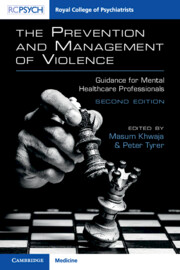Book contents
- The Prevention and Management of Violence
- The Prevention and Management of Violence
- Copyright page
- Dedication
- Contents
- Contributors
- Preface
- Abbreviations
- Section 1 General Aspects of Management
- Section 2 Medical and Psychological Intervention
- Section 3 Violence in Different Settings
- Section 4 Management in Other Groups
- Section 5 Violence and Society
- Introduction to Section 5
- Chapter 17 Criminal and Youth Justice Liaison and Diversion Systems
- Chapter 18 Information-Sharing, Including With Victims of Crime Committed by Persons With Mental Disorders
- Chapter 19 Victims of Violence
- Section 6 Engagement and Understanding
- Index
- References
Chapter 19 - Victims of Violence
from Section 5 - Violence and Society
Published online by Cambridge University Press: 09 May 2023
- The Prevention and Management of Violence
- The Prevention and Management of Violence
- Copyright page
- Dedication
- Contents
- Contributors
- Preface
- Abbreviations
- Section 1 General Aspects of Management
- Section 2 Medical and Psychological Intervention
- Section 3 Violence in Different Settings
- Section 4 Management in Other Groups
- Section 5 Violence and Society
- Introduction to Section 5
- Chapter 17 Criminal and Youth Justice Liaison and Diversion Systems
- Chapter 18 Information-Sharing, Including With Victims of Crime Committed by Persons With Mental Disorders
- Chapter 19 Victims of Violence
- Section 6 Engagement and Understanding
- Index
- References
Summary
This chapter provides an overview of violence and victimisation. This includes consideration of the complex relationship between mental health and violence, highlighting the increased risk of violent victimisation experienced by individuals suffering from mental illness. The developing impact of the COVID-19 pandemic and associated health measures such as lockdown orders on violence (and, in particular, domestic abuse) is explored. We describe the history and development of legal protections and statutory services for victims in the United Kingdom. This includes the 2021 Victims’ Code. The authors discuss public health strategies in the conceptualisation and prevention of violence, and there is consideration of future developments within this field. Current resources available for victims of violence are outlined, alongside a detailed list of organisations that individuals who have been victimised can contact for advice and support.
Keywords
- Type
- Chapter
- Information
- The Prevention and Management of ViolenceGuidance for Mental Healthcare Professionals, pp. 300 - 316Publisher: Cambridge University PressPrint publication year: 2023



